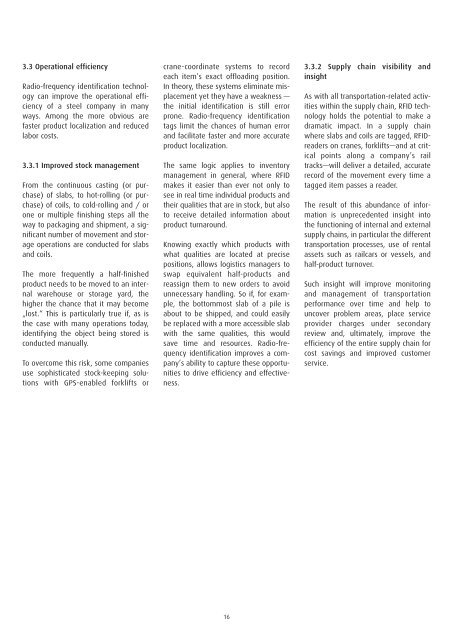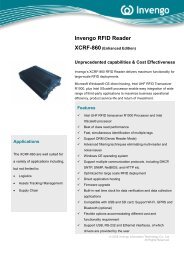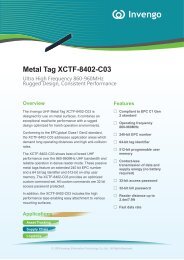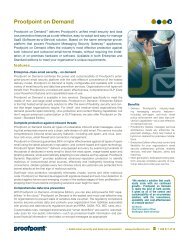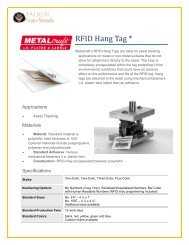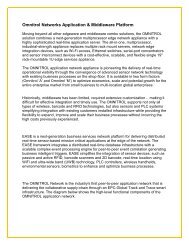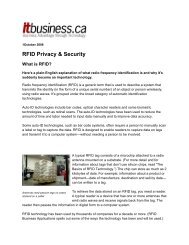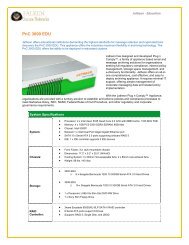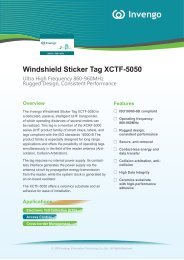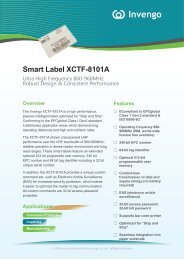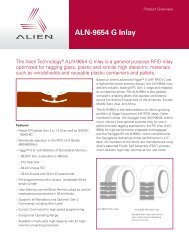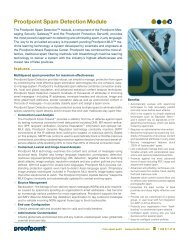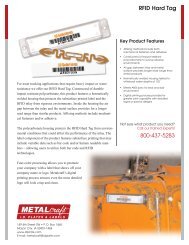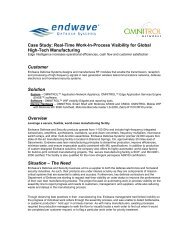The Benefits of RFID for Slab- and Coil-Logistics - Falken Secure ...
The Benefits of RFID for Slab- and Coil-Logistics - Falken Secure ...
The Benefits of RFID for Slab- and Coil-Logistics - Falken Secure ...
You also want an ePaper? Increase the reach of your titles
YUMPU automatically turns print PDFs into web optimized ePapers that Google loves.
3.3 Operational efficiency<br />
Radio-frequency identification technology<br />
can improve the operational efficiency<br />
<strong>of</strong> a steel company in many<br />
ways. Among the more obvious are<br />
faster product localization <strong>and</strong> reduced<br />
labor costs.<br />
3.3.1 Improved stock management<br />
From the continuous casting (or purchase)<br />
<strong>of</strong> slabs, to hot-rolling (or purchase)<br />
<strong>of</strong> coils, to cold-rolling <strong>and</strong> / or<br />
one or multiple finishing steps all the<br />
way to packaging <strong>and</strong> shipment, a significant<br />
number <strong>of</strong> movement <strong>and</strong> storage<br />
operations are conducted <strong>for</strong> slabs<br />
<strong>and</strong> coils.<br />
<strong>The</strong> more frequently a half-finished<br />
product needs to be moved to an internal<br />
warehouse or storage yard, the<br />
higher the chance that it may become<br />
„lost.“ This is particularly true if, as is<br />
the case with many operations today,<br />
identifying the object being stored is<br />
conducted manually.<br />
To overcome this risk, some companies<br />
use sophisticated stock-keeping solutions<br />
with GPS-enabled <strong>for</strong>klifts or<br />
crane-coordinate systems to record<br />
each item’s exact <strong>of</strong>floading position.<br />
In theory, these systems eliminate misplacement<br />
yet they have a weakness —<br />
the initial identification is still error<br />
prone. Radio-frequency identification<br />
tags limit the chances <strong>of</strong> human error<br />
<strong>and</strong> facilitate faster <strong>and</strong> more accurate<br />
product localization.<br />
<strong>The</strong> same logic applies to inventory<br />
management in general, where <strong>RFID</strong><br />
makes it easier than ever not only to<br />
see in real time individual products <strong>and</strong><br />
their qualities that are in stock, but also<br />
to receive detailed in<strong>for</strong>mation about<br />
product turnaround.<br />
Knowing exactly which products with<br />
what qualities are located at precise<br />
positions, allows logistics managers to<br />
swap equivalent half-products <strong>and</strong><br />
reassign them to new orders to avoid<br />
unnecessary h<strong>and</strong>ling. So if, <strong>for</strong> example,<br />
the bottommost slab <strong>of</strong> a pile is<br />
about to be shipped, <strong>and</strong> could easily<br />
be replaced with a more accessible slab<br />
with the same qualities, this would<br />
save time <strong>and</strong> resources. Radio-frequency<br />
identification improves a company’s<br />
ability to capture these opportunities<br />
to drive efficiency <strong>and</strong> effectiveness.<br />
16<br />
3.3.2 Supply chain visibility <strong>and</strong><br />
insight<br />
As with all transportation-related activities<br />
within the supply chain, <strong>RFID</strong> technology<br />
holds the potential to make a<br />
dramatic impact. In a supply chain<br />
where slabs <strong>and</strong> coils are tagged, <strong>RFID</strong>readers<br />
on cranes, <strong>for</strong>klifts—<strong>and</strong> at critical<br />
points along a company’s rail<br />
tracks—will deliver a detailed, accurate<br />
record <strong>of</strong> the movement every time a<br />
tagged item passes a reader.<br />
<strong>The</strong> result <strong>of</strong> this abundance <strong>of</strong> in<strong>for</strong>mation<br />
is unprecedented insight into<br />
the functioning <strong>of</strong> internal <strong>and</strong> external<br />
supply chains, in particular the different<br />
transportation processes, use <strong>of</strong> rental<br />
assets such as railcars or vessels, <strong>and</strong><br />
half-product turnover.<br />
Such insight will improve monitoring<br />
<strong>and</strong> management <strong>of</strong> transportation<br />
per<strong>for</strong>mance over time <strong>and</strong> help to<br />
uncover problem areas, place service<br />
provider charges under secondary<br />
review <strong>and</strong>, ultimately, improve the<br />
efficiency <strong>of</strong> the entire supply chain <strong>for</strong><br />
cost savings <strong>and</strong> improved customer<br />
service.


